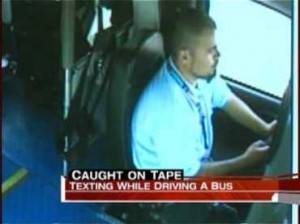
BISC calls for better enforcement of moving violations
By Norman Littler
 Most state transportation departments that conduct commercial vehicle inspections focus primarily on the vehicle, when in fact vehicular issues represent only 5- percent of all moving violations.
Most state transportation departments that conduct commercial vehicle inspections focus primarily on the vehicle, when in fact vehicular issues represent only 5- percent of all moving violations.
This raises the question as to why so much money and attention is going toward such a small part of the problem when the bigger issue clearly lies with the driver.
This year the Bus Industry Safety Council (BISC) is appealing to all safety and enforcement organizations to take a closer look at driver-related safety concerns to help prevent serious bus accidents. The focus needs to shift from vehicles to drivers.
Cameras are everywhere
Over the past year several dramatic video clips of catastrophic bus crashes circulated over the Internet as sensationalism and dark humor. But viewed in a more critical light, they illustrate precisely what BISC wants to prevent.
The drivers in all three videos could have prevented what ensued by exercising safer driving habits.
Video Clip: Watch Turkish Bus Crash
This coach crash occurred in Turkey and is the first instance of a rollover coach accident caught on video. With the prevalence of cameras and cell phones, operators will undoubtedly have the opportunity to view more accidents captured by onlookers.
The question in this case is which driver is at fault? Answer: both are in error. The driver of the passenger car fails to consider the distance and speed of the oncoming motorcoach and turns into its path.
While it may look like the taxi triggered the chain of events, the coach driver was on a steep downgrade traveling too fast for the wet road conditions. He also failed to anticipate the possibility of the passenger car pulling into his path. Anyone who practices defensive driving will always try to be ready for the unexpected.
Video Clip: www.liveleak.com
Another incident caught on video shows bad driving habits in play behind the wheel of a commercial vehicle. The lead motorcoach was following the passenger car much too closely as it slowed to enter the turn. The collision forced both the car and the front of the bus into the path of the approaching concrete mixer. The coach driver had no time to react and stop, or even turn to avoid the vehicle.
The second motorcoach also was following at a less than safe distance. Through more luck than anything the driver barely avoided a second collision.
Video Clip: www.youtube.com/watch?v=1M74j8LvX6k
The manic urge to text-message obviously distracted the driver caught on this video. Surely he was aware of the video event recorder that would capture his every action. Nonetheless he still chose to engage in the extremely unsafe and prohibited activity.
Any trooper in a cruiser can spot this behavior. They see it everyday. BISC remains convinced enforcement officers are not taking this matter as seriously as they should.
A study on prior violations
A report from the University of Michigan Transportation Research Institute makes a comparison between schools, transit, scheduled intercity and charter bus driver violation patterns. (FIG.1.) The statistically significant findings on charter bus drivers’ prior violations are meaningful.
 However charter tour coach drivers had higher proportions on each measure except for DWI, and the differences were statistically significant at the 0.05 level for suspensions, speeding, other moving violations, and any violation or accident.
However charter tour coach drivers had higher proportions on each measure except for DWI, and the differences were statistically significant at the 0.05 level for suspensions, speeding, other moving violations, and any violation or accident.
The proportions of charter coach drivers with speeding violations or other moving violations within the last three years were each around twice that of school bus drivers. Almost 45 percent of charter coach drivers had either a traffic violation or crash within the last three years, compared with about 30 percent of school bus drivers.
The vast majority of coach operators go to great lengths to hire professionals with the skills and sensibility to operate their vehicles in the safest fashion possible. Unfortunately, they do not always succeed. There are still too many companies and drivers that exhibit bad habits.
Based on the recent findings from Federal Motor Carrier Safety Administration Large Truck Crash Causation Study, the American Transportation Research Institute (ATRI) conducted further investigation into crash prediction based on driver behavior.
The ATRI results below relate only to drivers of large trucks. However, the causation findings presented in the UMTRI research lead BISC to believe this industry can reasonably anticipate similar findings and predictions for bus and motorcoach drivers.
In a summary of all data analyzed the crash likelihood increases with the type of violation or conviction on a driver’s record
Higher odds of accidents with categorical violations
- Reckless driving violation 325%
- Improper turn conviction 105%
- Improper or erratic lane change conviction 100%
- Failure to yield right of way conviction 97%
- Improper turn violation 94%
- Failure to maintain proper lane conviction 91%
- A past accident on record 87%
- Improper Lane Change violation 78%
- Failure to yield right of way violation 70%
- Driving too fast for conditions conviction 62%
BISC wants zero tolerance enforcement
Just good old-fashioned traffic law enforcement would go along way in improving the situation.BISC has requested IACP consider the establishment of a North American zero tolerance enforcement campaign against aggressive and unsafe driving by all bus and coach drivers.
- BISC wants a policy that insists that any enforcement officer pull over and cite any bus or coach driver he observes operating in an unsafe manner.
- Instruct the officer to explain to passengers why the stop is necessary; that the officer has the utmost regard for the safety of the traveling public.
- Go to court and press the charge, and appeal to the court not to reduce or mask the charge since this action allows unsafe drivers to continue to operate and endanger the public.
This industry needs to hold bus drivers to standards equal to airline pilots, as the responsibilities to the traveling public are identical. Bus and coach passengers expect the same level of care and concern.
Norman Littler serves as vice president of regulatory and legislative affairs for the American Bus Association (ABA).
